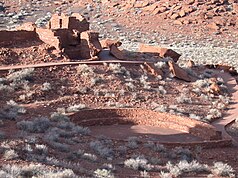Wupatki National Monument
| Wupatki National Monument | ||
|---|---|---|
| Anasazi ruin | ||
|
|
||
| Location: | Arizona , United States | |
| Next city: | Flagstaff | |
| Surface: | 143.3 km² | |
| Founding: | December 9, 1924 | |
| Visitors: | 239,600 (2007) | |
Wupatki National Monument is a protected area of the National Park Service of the type of national monuments north of the city Flagstaff in US -Bundesstaat Arizona . Almost 2,600 prehistoric sites have been discovered in the 140 km² national monument , including the ruins of pueblos of the Anasazi culture.
The history of the settlements is strongly influenced by the eruption of the neighboring volcano Sunset Crater in the years 1064/1065. It is not known why the previously sparse settlement activity in the area increased sharply after the eruption. The improved water storage of the volcanic ashes may have contributed to the fertility of the soil.
The Wupatki ruin was the largest known structure on the North American continent in the 12th century. Between 85 and 100 people lived in it, and the population in the immediate vicinity is estimated at several thousand. The Anasazi lived on corn , pumpkin and beans . They hunted pronghorns and rodents and picked berries. They created artistically painted ceramics and wore clothes made of woven and brightly colored textiles. Pottery shards show that there were trade links throughout the southwest of what is now the United States.
Since October 15, 1966, the site has been listed on the National Register of Historic Places in Arizona . It is also listed by the National Park Service as a National Historic Landmark because it had a special historical significance as a National Monument even before this program began in 1960.
Adjacent protected areas
Web links
- National Park Service: Wupatki National Monument (official site; English)
Individual evidence
- ↑ Wupatki National Monument in the National Register Information System. National Park Service , accessed July 28, 2017.


